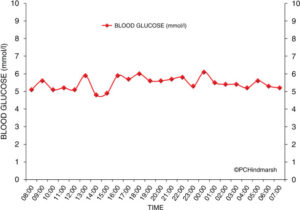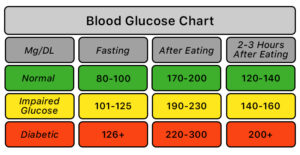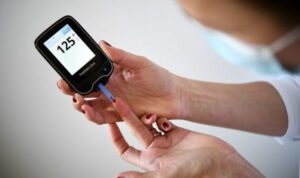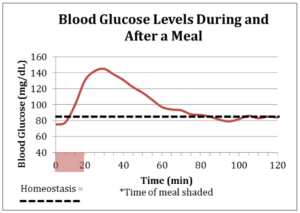Contents
- 1 Blood Sugar Chart
- 2 What Are Normal Blood Sugar Levels?
- 3 Blood Sugar Chart And Diabetes
- 4 What to Do When Levels Are High?
- 5 What Can I Do if My Levels Are Too Low?
- 6 How To Do A Blood Sugar Chart?
- 7 Glucose Meter To Test Blood Sugar Levels
- 8 Blood Sugar Level Before And After Eating
- 9 How Does Blood Sugar Chart Help In Diet Plan?
- 10 Conclusion
Blood Sugar Chart
 You can chart your blood sugar to help control and manage this chronic illness. The more you know about your blood sugar level, the better prepared you’ll be to take care of your diabetes and live a healthier life. It offers important information on what to do when high or low levels are detected.
You can chart your blood sugar to help control and manage this chronic illness. The more you know about your blood sugar level, the better prepared you’ll be to take care of your diabetes and live a healthier life. It offers important information on what to do when high or low levels are detected.
If you are diabetic, how has it affected your life? What types of symptoms do you experience when your levels (high or low) are too high or too low? Diabetes is a chronic illness that affects the way our body uses blood sugar.
A blood sugar chart is a way to track the level of blood sugar over time. It tells you when peaks and valleys were highest or lowest. A normal blood sugar chart will span four hours, while an intensive chart will also include your nighttime hours.
A blood sugar chart can help you figure out what triggers your high or low values, and how to correct them with food, exercise, or medications. It can be helpful if you are on insulin or other medications to keep track of their effectiveness. You can also use the information in the chart to help make adjustments in your lifestyle to keep your blood sugar levels under control.
What Are Normal Blood Sugar Levels?
Sometimes it can be difficult to know what is a “normal” blood sugar level. This is because there are no truly normal values. It’s best to look at the range of levels of a person’s blood sugar and work with their doctor to get more information on what their values should be.
A normal fasting blood sugar level is between 70 and 100 milligrams per deciliter (mg/dl). According to the American Diabetes Association, a person’s blood sugar levels should fall into the following categories:

- Below 99 mg/dl = normal blood sugar
- 100-125 mg/dl = pre-diabetes (considered by most doctors as impaired glucose tolerance)
- 126-140 mg/dl = diabetes
This means that you have diabetes if your blood sugar level is 126 or higher after not eating anything for at least eight hours. If you are taking insulin, this number would be much lower because when you take insulin your body can keep your blood sugars in check. Even when you haven’t eaten in eight hours. You would not be diagnosed with diabetes unless your blood sugars were consistently over 126 mg/dl. Even when you are taking insulin to control it.
141-160 mg/dl = high blood sugar
Above this number = very high blood sugar; possibly coma imminent (please consult a doctor immediately).
A normal two-hour postprandial (after eating) blood sugar level is between 90 and 130 mg/dl after eating. But again there are no truly normal values of a person’s blood sugar levels. If your postprandial reading falls into the pre-diabetes range on a fasting test. Then your doctor might tell you that you have prediabetes or even diabetes if your readings stay in the higher range.
Blood Sugar Chart And Diabetes
It’s a chart that records your fasting blood sugar levels. You should fill it in before you eat, drink or exercise–or you can take a reading at any time of the day if you have symptoms of diabetes.
A blood sugar chart is the most popular of routine blood tests and may be ordered as part of a routine health check. A blood sugar chart gives an indication of how well-managed your diabetes is. It also provides valuable information on the management of diabetes or simply for general health purposes. It is a simple procedure that you take a reading from your blood then put it onto a chart.
Blood glucose monitoring helps people with diabetes, as well as those at risk for the disease, to control their condition by providing personal information about how different foods work in their bodies and what activities affect their sugar levels. The blood sugar chart will help you understand what affects your body’s response to certain foods or activities. It can show if you have hypoglycemia (low blood sugar) – especially important before physical activity. It also indicates if you have hyperglycemia (high blood sugar), which can mean that your diabetes treatment needs revising. Keeping a food diary together with the use of the glucose meter provides invaluable information for adjusting meal plans, meal portions, and learning about the effect of food on blood sugar levels.
How Does It Help In Managing Diabetes?
The more you know about your blood sugar level, the better prepared you’ll be to take care of your diabetes and live a healthier life. You can put together a chart that includes three or four blood sugar readings each day for at least two weeks. If using a meter, it’s best to test first thing in the morning on an empty stomach, as well as before and after meals on days when you’re less active.
You should evaluate your patterns from week to week by looking at periods of high levels versus those of low levels. High values may indicate overdoing insulin due to overeating or exercise; low values could mean not enough food throughout the day. A pattern of high after-meal levels may indicate that your medication is not working properly.
What to Do When Levels Are High?
You should seek medical attention immediately if your blood sugar level is above 240 mg/dl. Because this can lead to organ damage. The symptoms of diabetes include intense thirst, frequent urination, blurred vision, and blurry vision. Also, keep in mind that adults aged 40+ have diabetes. But have never experienced symptoms before developing intense thirst at around 230mg/dL. So this is probably not appropriate for all ages unless granulated based on the affected person.
If levels are between 180 and 239, then you can treat it with a simple meal or drink that contains 15g of carbohydrates and two to four ounces of juice. If you take insulin, only give yourself half of your usual amount and don’t take any more doses until you speak with your doctor about what to do next.
What Can I Do if My Levels Are Too Low?

If they become too low (below 80mg/dl) then consume some kind of fast-acting carbohydrate food such as soda crackers, glucose tablets, fruit juice, or hard candy. Or try foods that contain complex carbs from whole-grain bread and cereals since those will raise blood sugar levels slowly over a period of hours.
Eating a meal within 30 minutes or so could also work to raise your blood sugar levels. If you have diabetes, you should eat a healthy and well-balanced diet that includes whole grains, fruits, vegetables, and low-fat dairy products since this will help maintain a consistent blood sugar level throughout the day.
If you haven’t eaten for a while then drink fruit juice or non-diet soda to stay hydrated. However, avoid drinking too much water because it can lead to confusion and problems with how your kidneys process waste.
How To Do A Blood Sugar Chart?

If you have diabetes, you should eat a healthy and well-balanced diet that includes whole grains, fruits, vegetables, and low-fat dairy products since this will help maintain a consistent blood sugar level throughout the day. If you haven’t eaten for a while then drink fruit juice or non-diet soda to stay hydrated. However, avoid drinking too much water because it can lead to confusion and problems with how your kidneys process waste.
If they become too low (below 80mg/dl) then consume some kind of fast-acting carbohydrate food such as soda crackers, glucose tablets, fruit juice, or hard candy.
In addition, regular check-ups with a doctor who specializes in diabetes will help people with diabetes avoid or delay problems due to their disease. It is important for anyone who has diabetes to be under the care of an endocrinologist, vascular specialist (doctor specializing in diseases related to blood vessel function), a nephrologist (kidney doctor), or general practitioner (a doctor who treats many kinds of health problems that do not require surgery).
Glucose Meter To Test Blood Sugar Levels
The first step is to find out which meter will suit you. Some meters give accurate readings but are difficult to use. The cost of the equipment is another factor that needs consideration. There are many different types of glucose meters on the market ranging in price from $20 up to $300+. So do your homework before buying any supplies.
One more thing – whatever kind of glucose meter you select, it’s important to learn how to use it properly. So that readings can be as accurate as possible. Glucose meters do not test for ketones (they check blood glucose only). So if your doctor wants you to check for ketones make sure you ask him/her which meter should be used. In the following post, we will talk about how to use a blood sugar chart and what you need to look for when filling it in.
The next step is going to your doctor, who might prescribe special insulin testing strips, a glucometer, and a logbook. This equipment enables you to monitor your own home-based glucose levels accurately over time, as often as required. Blood sugar (glucose) levels rise after eating foods that contain carbohydrates, such as bread, cereals, pasta, rice, or fruit juices. A lot of factors can change your blood sugar level – these include the amount and type of food eaten and physical activity. The best way to monitor how different foods affect your blood sugar level is by using a blood sugar chart.
Blood Sugar Level Before And After Eating

It is not recommended that you eat before you get your blood sugar level checked. If it is necessary, then have just a small amount of something simple. Some examples are toast, crackers, or fruit juice. If you are checking your blood sugar level in the morning, do not check it right after you get up. Wait until at least two hours after waking up or until after breakfast, whichever comes last.
Blood sugar levels are different at bedtime than they are in the morning. To get accurate results be sure to take your glucose test when your body is ready for normal reading. This means fasting 8-12 hours before you take the test and don’t have diabetes medicines or insulin shots taken right before you take the test. It’s important to check your blood sugar level within 20 minutes of taking the test strip out of its vial because if bubbles form on the strip. This can give an inaccurate result. Also, be sure that all the air is out of the vial before you open it.
If your blood sugar is too low, wait until your blood sugar gets higher before testing again before starting a meal plan, your doctor needs to check your A1C level and know if you have kidney disease or not. However, you can ask for your doctor’s permission to start tracking your diet and exercise with a food diary or an electronic calorie counter if they are available in your area. If so, do so prior to getting started. Why? This way you can work together on monitoring what you are eating along with measuring how much activity you are doing during the day. Food records also provide information about how many calories are being consumed which helps people to make changes in diet and exercise if needed.
How Does Blood Sugar Chart Help In Diet Plan?
A blood sugar chart helps you to know what foods are good for you, which ones are bad for you, etc. It also helps people with diabetes decide what is best for them at a particular time. For example, certain foods could be eaten when your blood sugar is high. Because eating well-balanced meals help control blood sugars. If your blood sugar level is low then eating snacks that are high in carbohydrates would be useful to bring your blood sugars back up again. Measuring food intake by using a scale or measuring cups and spoons can help improve the consistency of how much food one eats daily. Because portion sizes differ from person to person even among people who have diabetes. Whereas an electronic calorie counter can measure these amounts.
It is also recommended that you take your blood glucose level at least four times per day. When first diagnosed, most doctors recommend taking readings before meals and one hour after eating along with two hours of postprandial reading at night before going to bed. Writing down your results will help you to know what foods affect your blood glucose the most. Keep in mind that some medications may alter the way certain food items affect your blood sugar level. So it is best to ask for guidance before eating anything new.
A blood glucose chart helps you to understand how many carbohydrates you eat. Carbohydrate counting can help people with diabetes better control their disease by assisting them at mealtime. Especially when someone has more complex diabetes or they are on insulin injections. As said earlier if your body does not produce enough insulin then knowing how many carbs you are eating becomes very important. Because excess carbohydrate remains in the bloodstream before being converted into energy. And this causes high levels of sugar in the bloodstream which leads to problems like retinopathy, nephropathy, neuropathy, high blood vessel disease, and heart disease.
Conclusion
If you have diabetes, maintaining good blood sugar levels is critical. The best way to do this is by following a regular meal plan that considers your individual needs and preferences. The chart below will help guide you on how much carbohydrate intake can be eaten at different times during the day for someone with type 1 or type 2 diabetes who is not taking insulin injections. If you want advice from professionals about what foods would work well for your specific disease, let us know.
Do you want to get rid of diabetes? Join our online diabetes consultation program and reverse your Diabetes naturally through lifestyle changes such as a Personalized Diet plan, Exercise, dieticians, and health coaches.


